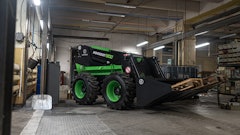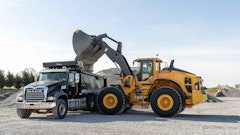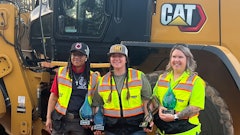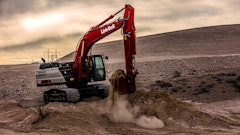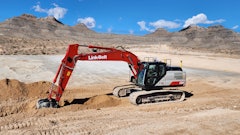Today’s excavators are increasingly sophisticated tools capable of handling far more than digging and dumping. Some have intricate electrical systems that assist them in “thinking” for themselves, while others are fine-tuned to take direct orders from the operator at the flip of a switch or push of a button.
Advanced hydraulic systems have also made the accuracy of their work exceptional. “These excavators have so much control and precision in the hydraulics that you could crack the shell of an egg without breaking the yolk,” says Bob Fiorenza, district sales manager at Liebherr Construction Equipment Co.
Different modes of excavation
Excavator manufacturers first introduced work modes and power modes in the 1990s. “Before there were modes, people would just reduce the engine rpm and try to handle what they had to do with lower rpm. They would also try to feather the joystick controls to gain more precision, and really a lot of machines didn’t have the fine control that they have today,” Fiorenza says.
Several excavator manufacturers now incorporate a variety of work modes and power modes for operators to choose from. By flipping a switch or turning a dial, these modes fine-tune hydraulic and engine output to match the job at hand.
For example, Volvo excavators are equipped with the Advanced Control System, or ACS, which matches hydraulic pump output to available engine horsepower. ACS includes idle (I), fine (F), general (G) and heavy (H) modes, plus nine engine rpm settings. Fine mode is suited for digging, lifting and precision work. General mode, with three throttle positions, is designed for excavating and truck loading while providing fuel savings.
Heavy mode gives the machine maximum engine rpm and hydraulic flow for any job that requires maximum output from an excavator.
Walter Reeves, project manager - excavators, Volvo Construction Equipment - North America, explains that choosing the correct modes can help a machine, and your operation, run more efficiently. “Most operators think that rpm is power and they go to the highest mode — this is incorrect,” he says. “The rpm gives you speed; hydraulic pressure gives you the force required in hard digging. If you always choose the Heavy (H) mode and are doing light and precise digging, you are working to slow the machine down, creating excessive heat and wasting fuel. This is hard on hydraulic components, driving up operating costs.”
Edward Wright, vice president of Fay and Wright Excavating Inc. in Goshen, CT, says the modes on the Volvo excavators his company uses are very convenient, as long as they’re being used properly. Wright trains his operators to understand the particular settings. “The mode we use most of the time is in the general (G) area,” Wright says. “That’s the area where I’d like the guys to run the machines — most of the time they don’t need to run full throttle.”
Liebherr also incorporates work modes into its excavators. Its full-size models have eco, lifting, power and fine modes. Power mode offers full throttle for heavy, demanding jobs that don’t require a lot of precision. For the operator looking to save money in fuel costs, eco-mode is the best choice.
“In eco-mode, you have a 4% reduction in production and a 20% reduction in fuel consumption,” Fiorenza explains. “If I owned a construction company, I would insist that the operator — especially with fuel costs today — run the machine in the economy mode. You can do anything in the economy mode. You’ll burn a lot less fuel and you’ll do almost the same amount of work.”
The lifting and fine modes also lead to fuel savings, yet provide the power and precision required for the application. “With fine mode, there’s about a 20% reduction in fuel consumption, but you’re not doing a lot of production in a fine mode. You’re doing some fine ditch cleaning, easy grading, working next to the foundation of a house or next to a gas line that’s underground,” Fiorenza says. “You have the same amount of power, but you’re not burning a lot of fuel because you’re doing fine work.”
Excavators think for themselves
Some manufacturers have taken a turn away from work modes in recent years. Instead, they are taking the decision-making process out of the hands of the operators and allowing the excavators to do the thinking.
John Deere’s C-Series excavators are equipped with the Powerwize II engine/hydraulic management system. This system has only one work mode and four engine speed, or “power”, modes.
“Most operators want maximum productivity, fast cycle times and maximum hydraulic flow,” says Mark Wall, product marketing manager for excavators, John Deere Construction and Forestry Division. “The one work mode in the Deere Powerwize II allows the operator to perform at maximum productivity in a variety of applications. Operators can perform truck loading, trenching, backfilling, lifting and fine grading without having to touch a switch. With the one work mode, operators do not have to worry about selecting the ‘best’ mode for the job.”
The operator can fine tune the engine speed using the power modes without changing the way the hydraulic flow is directed. The modes include “power”, which is used in most applications; “high power”, which increases the engine speed by 100 rpm when the arm-in or boom-up function reaches a preset pressure setting; “economy”, which allows the excavator to operate at a reduced rpm for light applications; and “auto accel”, which varies the engine rpm according to system pressure. “In light load applications, auto accel mode can save the owner approximately 10% in fuel, reducing owning and operating costs,” Wall says.
Caterpillar’s engine and hydraulic system designs take a further step down the road of “thinking” machines. Caterpillar has done away with its work mode and power mode switches completely and replaced them with automatic boom and swing priority, which selects the best work mode based on joystick movement.
“The operator input — the extent to which they move the lever, which lever they’re moving and how much they move it — tells the machine what kind of work the operator is expecting out of it,” says Jason Kern, hydraulic excavator marketing supervisor for Caterpillar. “If you pull the lever a little, you get a little; if you pull the lever a lot, you get a lot. There are electronics and hydraulics behind it, but simply put the machine senses the demand from the operator.”
Caterpillar began eliminating the work modes with its C-Series excavators in 2000. The transition on all excavators is expected to be completed in early 2005.
The company chose to make this switch based on what it was hearing from users in the field. “The feedback we were getting from our customers, and what we observed going out on jobsites, is that the modes weren’t being used at all or were being used improperly. So customers weren’t getting the full capability we designed into the machine,” Kern says. “When we went to our next generation, one of our design goals was to get the modes out of there and build them inherently into the machine so you wouldn’t have to choose what mode you wanted to be in.”
The result is fuel savings, quicker hydraulics and ease of training employees, says John Hepp, owner of John Hepp Excavating, Inc., Watertown, WI. His fleet includes a 2003 Caterpillar 320LC Utility model. “There is an advantage to putting new people on the CAT excavators without the mode system because everything changes automatically,” he says. “The machine can sense what the operator wants to do and it adjusts accordingly.”
The choice between multiple operating modes or a more automated design ultimately comes down to what you want to accomplish with the excavator. Assess the kind of work you expect out of the machine, and the degree of control you want your operators to have, to determine which design will be most productive and cost effective for your fleet.







